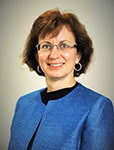Getting to the Heart of the Underdiagnosis and Undertreatment of Non-valvular Atrial Fibrillation: Integrating Optimal Screening, Team-Based Care and Digital Health Tools in Primary Care Settings
CMEO Live and On Demand
Premiere Date: Thursday, September 27, 2018
Live Broadcast: 12:00–1:30 p.m. ET
“After the Show” live Q&A webcast: 1:02 p.m.–1:30 p.m. ET
Taped Re-Air: 4:00–5:30 p.m. ET
This activity offers CE credit for:
- Physicians (CME)
- Nurses (CNE)
- Pharmacists (ACPE)
- ABIM MOC II
- Other
All other clinicians will receive a Certificate of Attendance stating this activity was certified for AMA PRA Category 1 Credit™
Credit Expiration Date: Friday, September 27, 2019
 |
Christopher P. Cannon, MD (Moderator) Director, Education, Cardiovascular Medicine Innovation Cardiovascular Division, Brigham and Women’s Hospital Professor of Medicine, Harvard Medical School Boston, MA |
 |
Deepak L. Bhatt, MD, MPH, , FACC, FAHA, FSCAI, FESC Executive Director of Interventional Cardiovascular Programs Brigham and Women’s Hospital Heart & Vascular Center Professor of Medicine, Harvard Medical School Boston, MA |
 |
Elaine M. Hylek, MD, MPH Director, Thrombosis and Anticoagulation Service Boston Medical Center Professor of Medicine Boston University School of Medicine Boston, MA |
Statement of Need
With the increasing age of the U.S. population, the “perceived” incidence of atrial fibrillation (AF) – the most common arrhythmia in clinical practice and a leading cause of morbidity and mortality – is increasing. However, patients may not notice symptoms that warrant care-seeking, which leads to physicians not having an index of suspicion relative to those at high risk for AF. Because AF is a major risk factor for thromboembolic disease and can lead to an increased risk for stroke, increased screening and use of anticoagulation treatment can help high-risk patients avoid these events.
However, as 20% or more of patients who have an AF-related stroke are not diagnosed until the time of stroke or shortly thereafter, screening and appropriate use of anticoagulants are suboptimal, and clinicians face challenges in understanding the tools available and strategies for implementing opportunistic and systematic screening in order to detect non-valvular atrial fibrillation (NVAF).
Given these challenges, expert faculty in this live, interactive CME Outfitters webcast address the impact of undiagnosed NVAF, the benefit and use of screening tools for early detection, appropriate implementation of oral anticoagulant therapy, and the use of digital health technologies to foster shared decision-making and collaborative care.
Learning Objectives
At the end of this CE activity, participants should be able to:
- Examine the significance of identifying patients at high risk for NVAF in the primary care setting who might benefit from anticoagulant therapy.
- Increase the rate of detection of NVAF by implementing both opportunistic and systematic screening in primary care settings to reduce the risk of stroke and death.
- Implement guideline-directed therapy for the appropriate use of oral anticoagulants in patients with NVAF to mitigate the risk of stroke.
The following learning objectives pertain only to those requesting CNE or CPE credit:
- Explain the significance of identifying patients at high risk for NVAF in the primary care setting who might benefit from anticoagulant therapy.
- Describe how NVAF screening in the primary care setting can reduce the risk of stroke and death.
- Identify guideline-directed therapy for the appropriate use of oral anticoagulants in patients with NVAF that will mitigate the risk of stroke.
Financial Support
Supported by an educational grant from the Bristol-Myers Squibb and Pfizer Alliance.
Target Audience
Primary care physicians, cardiologists, physician assistants, nurse practitioners, nurses, and pharmacists who treat patients with non-vascular atrial fibrillation.
Credit Information
CME Credit (Physicians):
CME Outfitters, LLC, is accredited by the Accreditation Council for Continuing Medical Education (ACCME) to provide continuing medical education for physicians.
CME Outfitters, LLC, designates this live activity for a maximum of 1.5 AMA PRA Category 1 Credit(s)™. Physicians should claim only the credit commensurate with the extent of their participation in the activity.
CNE Credit (Nurses):
Provider approved by the California Board of Registered Nursing, Provider Number CEP 15510, for 1.5 contact hours.
Note to Nurse Practitioners and Clinical Nurse Specialists: the content of this activity pertains to pharmacology. Earn up to 1.5 contact hours of pharmacotherapeutic contact hours.
Note to Nurse Practitioners: Nurse Practitioners can apply for AMA PRA Category 1 Credit™through the American Academy of Nurse Practitioners (AANP). AANP will accept AMA PRA Category 1 Credit™ from organizations accredited by the Accreditation Council for Continuing Medical Education. Nurse practitioners can also apply for credit through their state boards.
CPE Credit (Pharmacists):
![]() CME Outfitters, LLC, is accredited by the Accreditation Council for Pharmacy Education as a provider of continuing pharmacy education. 1.5 contact hours (0.15 CEUs) Universal Activity Number:
CME Outfitters, LLC, is accredited by the Accreditation Council for Pharmacy Education as a provider of continuing pharmacy education. 1.5 contact hours (0.15 CEUs) Universal Activity Number:
Live: 0376-0000-18-022-L01-P
Enduring: 0376-0000-18-022-H01-P
Type: Knowledge-based
ABIM/MOC Credit:
Successful completion of this CME activity, which includes participation in the evaluation component, enables the participant to earn up to 1.5 MOC points in the American Board of Internal Medicine’s (ABIM) Maintenance of Certification (MOC) program. Participants will earn MOC points equivalent to the amount of CME credits claimed for the activity. It is the CME activity provider’s responsibility to submit participant completion information to ACCME for the purpose of granting ABIM MOC credit.
Learning Formats
Live activity
Enduring material
MIPS Improvement Activity: This activity counts towards MIPS Improvement Activity requirements under the Medicare Access and CHIP Reauthorization Act of 2015 (MACRA). Clinicians should submit their improvement activities by attestation via the CMS Quality Payment Program website.
Note to Physician Assistants: AAPA accepts certificates of participation for educational activities certified for AMA PRA Category 1 Credit™ from organizations accredited by the Accreditation Council for Continuing Medical Education.
Post-tests, credit request forms, and activity evaluations must be completed online at www.cmeoutfitters.com/TST28429 (requires free account activation), and participants can print their certificate or statement of credit immediately (75% pass rate required). This website supports all browsers except Internet Explorer for Mac. For complete technical requirements and privacy policy, visit www.neurosciencecme.com/technical.asp.
It is the policy of CME Outfitters, LLC, to ensure independence, balance, objectivity, and scientific rigor and integrity in all of their CE activities. Faculty must disclose to the participants any relationships with commercial companies whose products or devices may be mentioned in faculty presentations, or with the commercial supporter of this CE activity. CME Outfitters, LLC, has evaluated, identified, and attempted to resolve any potential conflicts of interest through a rigorous content validation procedure, use of evidence-based data/research, and a multidisciplinary peer review process. The following information is for participant information only. It is not assumed that these relationships will have a negative impact on the presentations.
Dr. Cannon reports that he receives research grants from Amgen Inc.; Boehringer-Ingelheim (BI); Bristol-Myers Squibb Company (BMS); Daiichi Sankyo; Janssen Pharmaceuticals, Inc.; Merck & Co., Inc. He is a consultant for Alnylam Pharmaceuticals, Inc.; Amarin Corporation; Amgen Inc.; Boehringer-Ingelheim (BI); Bristol-Myers Squibb Company (BMS); Eisai Inc.; Janssen Pharmaceuticals, Inc.; Kowa Pharmaceuticals America, Inc.; Merck & Co., Inc.; Pfizer Inc.; Regeneron Pharmaceuticals, Inc.; sanofi-aventis U.S. LLC.
Dr. Bhatt reports that he receives research grants from Abbott; Amarin Corporation; Amgen Inc.; Astra Zeneca; Bayer Corporation; Boehringer Ingelheim; Bristol-Myers Squibb Company; Chiesi USA, Inc.; Eisai Inc.; Ethicon USA, LLC; Forest Laboratories; Idorsia Pharmaceuticals Ltd; Ironwood Pharmaceuticals, Inc.; Ischemix; Lilly USA; Medtronic; PhaseBio Pharmaceuticals, Inc.; Pfizer Inc.; Regeneron; Roche; sanofi-aventis U.S. LLC; Synaptic; and The Medicines Company.
Dr. Hylek reports that she received a research grant from Janssen Pharmaceuticals, Inc. Speakers sympoisa for Boehringer Ingelheim; Bristol-Myers Squibb Company; Medtronic; Pfizer Inc. She is consultant for Bristol-Myers Squibb Company; Janssen Pharmaceuticals, Inc.; Medtronic
Dr. Helfand (peer reviewer) has no disclosures to report.
Ms. Ochoa (peer reviewer) has no disclosures to report.
Kashemi D. Rorie, PHD (planning committee) has no disclosures to report.
Sharon Tordoff (planning committee) has no disclosures to report.
Disclosures were obtained from the CME Outfitters, LLC staff: No disclosures to report.
Faculty of this CE activity may include discussions of products or devices that are not currently labeled for use by the FDA. The faculty have been informed of their responsibility to disclose to the audience if they will be discussing off-label or investigational uses (any uses not approved by the FDA) of products or devices.
